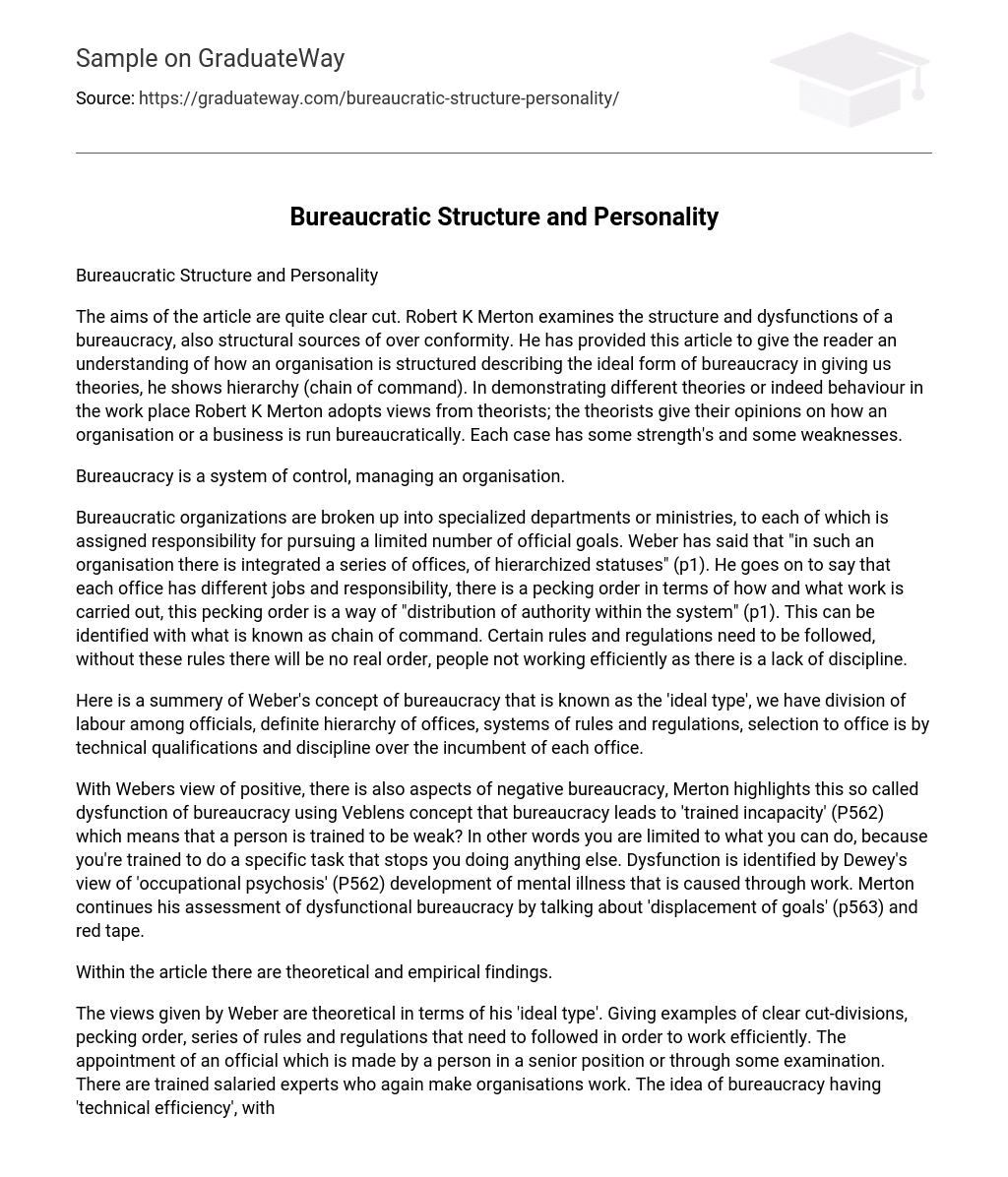The aims of the article are quite clear cut. Robert K Merton examines the structure and dysfunctions of a bureaucracy, also structural sources of over conformity. He has provided this article to give the reader an understanding of how an organisation is structured describing the ideal form of bureaucracy in giving us theories, he shows hierarchy (chain of command). In demonstrating different theories or indeed behaviour in the work place Robert K Merton adopts views from theorists; the theorists give their opinions on how an organisation or a business is run bureaucratically. Each case has some strength’s and some weaknesses.
Bureaucracy is a system of control, managing an organisation.
Bureaucratic organizations are broken up into specialized departments or ministries, to each of which is assigned responsibility for pursuing a limited number of official goals. Weber has said that “in such an organisation there is integrated a series of offices, of hierarchized statuses” (p1). He goes on to say that each office has different jobs and responsibility, there is a pecking order in terms of how and what work is carried out, this pecking order is a way of “distribution of authority within the system” (p1). This can be identified with what is known as chain of command. Certain rules and regulations need to be followed, without these rules there will be no real order, people not working efficiently as there is a lack of discipline.
Here is a summery of Weber’s concept of bureaucracy that is known as the ‘ideal type’, we have division of labour among officials, definite hierarchy of offices, systems of rules and regulations, selection to office is by technical qualifications and discipline over the incumbent of each office.
With Webers view of positive, there is also aspects of negative bureaucracy, Merton highlights this so called dysfunction of bureaucracy using Veblens concept that bureaucracy leads to ‘trained incapacity’ (P562) which means that a person is trained to be weak? In other words you are limited to what you can do, because you’re trained to do a specific task that stops you doing anything else. Dysfunction is identified by Dewey’s view of ‘occupational psychosis’ (P562) development of mental illness that is caused through work. Merton continues his assessment of dysfunctional bureaucracy by talking about ‘displacement of goals’ (p563) and red tape.
Within the article there are theoretical and empirical findings.
The views given by Weber are theoretical in terms of his ‘ideal type’. Giving examples of clear cut-divisions, pecking order, series of rules and regulations that need to followed in order to work efficiently. The appointment of an official which is made by a person in a senior position or through some examination. There are trained salaried experts who again make organisations work. The idea of bureaucracy having ‘technical efficiency’, with a premium placed on precision, speed, expert control, continuity, discretion and optimum returns on input (p561), introduction of pensions, increasing salaries and regularised procedures of promotion giving incentives to workers.
In theory all looks well, however empirical findings has shown a different side to bureaucracy that highlights some clear weaknesses. When people follow rules there comes a point where people get so tied in rules which leads to them missing the main goals. Veblen’s ‘trained incapacity’ that has been mentioned shows empirical findings of people not able to progress as they are only trained in one particular job, they are not flexible which leaves them ultimately in a stale mate position ‘abilities to function as inadequacies’ skills that have been successful in the past may produce inappropriate responses under changed conditions. Dewey’s ‘occupational psychosis’ gives an example of how workers can become so called brain dead as a result of repetitive work.
‘A common destiny for the people who work together, sharing same interests especially since there is little competition as far as promotion is in terms of seniority’ (P546) leads to aggression in groups to be minimised this is a positive thing allowing workers to perhaps motivate each other, but this informal social organisation may give way to favouritism in other words workers supporting each other but in doing so there is neglection of clients and higher officials.
To conclude Robert K Merton’s arguments are convincing he starts by telling us about the good of bureaucracy, and then he reveals the dysfunctions. One of the dysfunctions is the effect of personality that creates over conformity. People start to think about the rules rather then the aims, this because of trained incapacity, however as people we can not expect to abide by every single rule, and what one has to do become what one ought to do. People do not know how to cope with different situations.
Bureaucracy demands devotion to regulations. The people at the top have the full picture but those at the bottom don’t.





